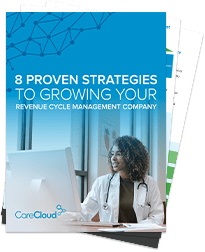Healthcare organizations in the U.S. are under growing financial pressure. The claim denial rates are around 15-20%*. Claim denial rates are reaching as high as 20%* in some specialties, and administrative costs consume almost 30%* of the healthcare spending. Therefore, the traditional revenue cycle management approaches are unable to cater to the healthcare sector’s new requirements. The once sufficient manual processes are now causing a slow-down that could jeopardize the sustainability of healthcare organizations.
The AI-powered RCM solutions are transforming healthcare by automating complex task s, reducing errors, and accelerating cash flow. By introducing smart coding systems, predictive analytics platforms, and others, AI is reshaping the entire field of revenue cycle management of the healthcare sector, providing a wide range of solutions that were beyond imagination some years back.
Traditional RCM Challenges Healthcare Faces Today
1. Manual Processes and Human Error
Healthcare firms are still very much dependent on manual data entry which is error-prone and time-consuming. Medical billing and coding personnel are continuously engaged in a long process of clinical documentation transcription, patient information verification, and diagnosis and procedure code assignment. The result is the slowdown of the revenue cycle by months and sometimes even the creation of coding backlogs that are several weeks long.
Human mistakes in conventional RCM procedures can amount to as much as 10-15%*, which will then result in claim rejections, payment delays, and ultimately loss of revenue. Manual billing has already caused employees’ burnout and high turnover rates to become operational challenges that cannot be overlooked. To add to this, healthcare institutions not only have to hire sufficient staff but also have to make sure that the workers are accurate in their work because of the complexity of the regulations surrounding the industry.
2. Claim Denials and Revenue Loss
According to industry data, hospitals and clinics are facing difficulty with claim rejections of 15-20% that vary by specialty, with some even greater. Every denied claim means an expensive and lengthy appeal process which can delay the payment cycle by 30-60 days or even longer. The extra workload of resubmitting and appealing claims takes away from patient care the resources that are quite valuable.
The delays in the revenue cycle are a major concern to the cash flow in the healthcare sector, especially for smaller medical practices and community hospitals. The overall impact of claim denials, slow payment cycles, and lack of efficiency in administration can lead to a situation where thousands or even millions of dollars in revenue are delayed or lost every year.
3. Regulatory Compliance Complexity
The health sector regulations are changing at a very fast pace, and with that, there are changes in coding that the payer’s policies have to conform to along with the compliance regulations that have to be followed.
In addition, associations must deal with the complicated interactions that exist between them and the numerous insurance companies which each have their peculiar requirements for documentation and submission methods. To ensure compliance across this scattered area poses a big challenge in terms of costs and expertise, which many organizations have a hard time getting internally.
How AI is Revolutionizing Revenue Cycle Management (RCM)
1. Automated Medical Billing and Coding
The systems used in medical billing and coding powered by AI are significantly enhancing accuracy and at the same time cutting down the process time. The technology called natural language processing (NLP) is now capable of examining clinical documents and recognizing the needed diagnosis and procedure codes automatically with an accuracy of more than 95%. The systems are being trained based on past coding practices and are through their machine learning algorithms, getting better in performance continually.
Cutting-edge AI platforms give real-time coding suggestions and corrections which assist coders in working more productively and at the same time keeping high accuracy standards. The automated code assignment and validation processes get rid of numerous coding errors that were usually the reason for claiming denials. The technology can very quickly cross-check the clinical documentation with the coding guidelines in use at that moment to make sure that the latest regulatory requirements are being followed.
The modern AI systems are capable of processing the coding backlogs in hours rather than days, which in turn significantly speeds up the revenue cycle timeline. The solutions provided by CareCloud is a good example of how intelligent automation is able to change the coding workflows, cutting down the manual intervention, and at the same time increasing the accuracy and throughput of the whole process.
2. Intelligent Claim Processing and Management
The automation in Revenue Cycle Management has brought a complete change in the claim submissions by the use of very sophisticated processing workflows. The AI systems are able to scrub the claims before submission automatically, identify the potential issues that might result in denials, and correct them proactively. This process of validation prior to submission results in a notable decrease in claim denial rates and, thus, quicker payment cycles.
Predictive analytics features allow health care companies to judge the chances of a claim getting approved even before it is sent in, thus allowing the selective prioritization of the claims that have the highest value and are least risky. In addition, AI-powered systems can predict the denial and delay of which claims would be a direct result of the behavior patterns of different payers in the past, hence allowing the development of different strategies for intervention to be proactive.
3. Enhanced Patient Eligibility and Benefits Verification
The role of automated real-time eligibility verification has been significant in the transformation of patient registration and final approval regarding the financial aspect. AI systems will be able to give instant access to various insurance databases to check coverage, determine benefits limitations, and notify possible problems even before the patients receive the services. This kind of advance prevention is what shuts the door on the majority of claim denials related to eligibility that used to occur after the service had been provided for weeks.
By making it easier for patients to register, the administrative burden is lightened and at the same time, data accuracy is improved. Solutions powered by AI for verification can find out and rectify typical data entry mistakes, so that patient demographic and insurance information is from the very first encounter.
4. Predictive Analytics for Revenue Optimization
The ability of AI algorithms to spot payment patterns and to make predictions regarding the account’s actions by considering the historical data and demographic factors is nothing short of excellent. These systems analyze thousands of variables to identify high-risk accounts early, enabling more targeted and effective collection strategies.
The use of optimized collection strategies that rely on predictive modeling increases the recovery rates while at the same time decreasing the costs of the collection process. The AI system is capable of advising the different patient populations on the best collection methods, and at the same time, the outreach effort will be timed for maximum impact, which will be done without making the patient feel negatively about the organization.
Key Benefits of AI-Powered RCM Solutions
1. Operational Efficiency Gains
Healthcare organizations that adopt AI-based RCM systems automatically get a 40-60%* reduction in their manual processing time in most cases. The elimination of standard data entry processes through automated workflows saves on administration costs and allows the staff to concentrate on activities of a higher value that have a direct impact on patient care and financial performance.
2. Financial Performance Improvements
With AI-powered RCM systems, the clean claim rates usually rise to 95%* or even more, while the average for non-AI traditional processes remains at 75-85%*. Such an upgrade of the clean claim rate directly results in quicker payment cycles and better cash flow.
3. Enhanced Accuracy and Compliance
AI minimizes human error that is the major cause of claim denial and non-compliance. Claims are also subjected to automated validation, which makes sure that they meet the current regulatory requirements and payer specifications before they are even submitted.
Implementation for AI in Healthcare RCM
1. Technology Integration Challenges
The issue of EHR system compatibility is one of the main factors that organizations take into account when they decide on the implementation of AI technologies. Organizations have to analyze how AI RCM solutions are going to be integrated with the current clinical and administrative systems, thus making sure that there is an uninterrupted data transition and very little disruption of the workflow.
Data migration requirements can be complex, particularly for organizations with legacy systems or multiple disparate platforms. Successful implementation requires careful planning to ensure data integrity and continuity of operations during the transition period.
2. ROI and Cost-Benefit Analysis
Initial investment in AI technology typically pays for itself within 12-18* months through improved efficiency and reduced denial rates. Organizations should evaluate long-term savings potential against upfront implementation costs, considering both direct financial benefits and indirect operational improvements.
3. Vendor Selection Criteria
Healthcare organizations looking to improve revenue cycle management through technology choices should prioritize vendors with proven healthcare expertise and robust integration capabilities. Key features to evaluate include scalability, security compliance, and ongoing support services.
The Future of Healthcare Revenue Cycle Management (RCM)
1. Emerging AI Technologies
Machine learning advancements continue to push the boundaries of what’s possible in automated revenue cycle management. Deep learning algorithms are becoming increasingly sophisticated at interpreting complex clinical documentation and identifying subtle patterns that impact revenue outcomes.
2. Industry Transformation Predictions
AI adoption in healthcare RCM is accelerating rapidly, with industry analysts predicting that 80%* of healthcare organizations will implement some form of AI-powered RCM technology within the next five years. This adoption will be driven by continued pressure to improve financial performance while managing increased regulatory complexity.
RCM automation is becoming standard practice rather than competitive advantage. Organizations that fail to adopt AI-powered solutions risk falling behind in operational efficiency and financial performance. The question is no longer whether to implement AI in RCM, but rather how quickly and comprehensively embrace these transformative technologies.
Final Thought
The transformation of healthcare revenue cycle management through artificial intelligence represents one of the most significant advances in healthcare administration in decades. From automated coding and intelligent claim processing to predictive analytics and real-time optimization, AI is addressing long-standing challenges that have plagued healthcare finance for years.
Healthcare organizations must now evaluate their current RCM capabilities and develop strategic plans for AI implementation. The technology is mature, the benefits are proven, and the competitive landscape increasingly favors organizations with advanced automation capabilities. Solutions from top RCM companies like CareCloud offer proven pathways to AI implementation with measurable results.
Frequently Asked Questions (FAQs)
What are the main challenges with traditional revenue cycle management that AI addresses?
AI addresses manual data entry errors (10-15%* error rates), high claim denial rates (15-20%*), and complex regulatory compliance requirements. It automates coding with 95%* accuracy and reduces processing delays from weeks to hours.
How quickly can healthcare organizations see ROI from implementing AI-powered RCM solutions?
Healthcare organizations typically see positive ROI within 12-18* months through 40-60%* reduction in manual processing time and improved clean claim rates from 75-85%* to 95%*.
What should healthcare organizations consider when selecting an AI vendor for RCM implementation?
Prioritize vendors with proven healthcare RCM expertise, seamless EHR integration capabilities, HIPAA compliance, scalability, and ongoing support services. Evaluate measurable results and case studies demonstrating improved clean claim rates and denial reduction.
How does AI improve the accuracy of medical coding and billing processes?
AI uses natural language processing to automatically assign diagnosis and procedure codes with 95%* accuracy while providing real-time suggestions and validation. It processes coding backlogs in hours rather than days and continuously learns to improve performance.
What does the future hold for AI adoption in healthcare revenue cycle management?
Industry analysts predict 80%* of healthcare organizations will implement AI-powered RCM technology within five years. AI adoption is transitioning from competitive advantage to standard practice for operational efficiency and financial performance.




